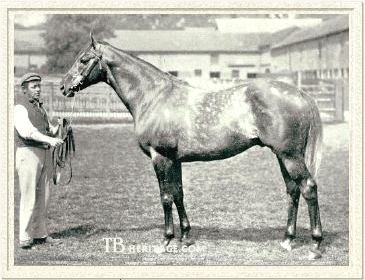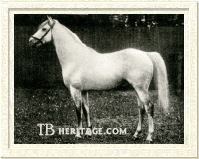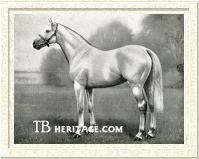|
|
Grey Leg

|
|
 |
|
|
Grey Leg was a handsome, sturdy grey colt who won at distances between 5 furlongs and 1-1/4 miles at the age of three. At the close of his racing career he was taking to Islington and presented as a Hunter Improvement Stallion, winning a Queen's Premium. Many a grey hunter and hack trace back to Grey Leg, but he did leave a mark in the racing world, having sired a number of modest winners of minor races from mostly less-fashionably bred mares, one of which became second dam of Rose Prince. Several classic winners and top French runners descend from Grey Leg through his daughters.
His sire was the grey Pepper and Salt (1882), a son of The Rake (by Wild Dayrell). His best win was the Princes of Wales' Stakes, and in the 1890s he was standing at the Duke of Westminster's Eaton stud for 100 guineas (Bend Or was standing at 200 guineas at the time), intended to be used as a sire of carriage horses.
His dam Quetta was a half-sister to Dongola who, in 1902, produced the future great broodmare Gondolette. In addition to Grey Leg, born in 1891, Quetta produced three good stakes winners: Cayenne (1892), a brother to Grey Leg, won the Criterion Stakes; Frontier, by Orme, won the Dewhurst Stakes and the King Edward VII Stakes, among other races; her daughter, Helm, by Morion, won the Yorkshire Oaks and the Coronation Stakes, and when shipped to Germany as a broodmare produced Hammurabi, winner of the German St. Leger, the Grosser Preis von Baden and other good races there.
Grey Leg, who reached 15.2 hands, was born a dark liver chestnut with white flecks in his coat, and even at age four, his legs were still liver-colored, while his body was spotted and flecked with patches of liver and grey, giving him a roan appearance that was considered "most attractive." By the age of ten, he was snow white, with some brown flecking. He had, it was said, "the gentlest of dispositions."
He proved to be a good, versatile runner. As a juvenile he ran three races in fourteen days, placing in the first two, and wining Newmarket's Two Year Old Plate. At age three he ran 13 races, winning five of them, including Newmarket's Champion Stakes, Doncaster's 5 furlong Portland Plate, and Epsom's 1-1/4 mile City and Suburban Handicap over a field of eleven. At age four he won the New Biennial Stakes and the All-Aged Stakes. His total winnings on the turf, with twelve wins and seven places in twenty-eight starts equalled £6.644. He stood at different places during his long career as a stallion, for a while at the Compton Stud in Dorsetshire. He was destroyed in 1916, and buried in the garden of Captain Ernest Tanner, at Newmarket.
Of his thoroughbred offspring, the unfashionably-bred SILVER SPRAY (1912,from Tiber, by St. Angelo) was his best filly on the turf, winning six of her ten starts at age two, including Doncaster's Hopeful Stakes and Epsom's Caterham Plate, and placing second twice, and third, to Silver Tag and Lady Josephine in the Cliftonville Plate at Brighton. Her daughter, Silver Grass was better class juvenile runner, wining the Palatine Nursery Handicap and placing second in the Acorn Stakes and the Queen Mary Stakes. A number of good runners descended from Silver Grass, including Exbury (1959, Prix de l'Arc de Triomphe, Coronation Cup, etc.).
|

Senseless was one of his better winners

Clydebridge (out of Jersey, by St. Simon) won five races and was second four times.
| |
His son, the "best tempered, best constitutioned, and soundest" SENSELESS (1905, from Senses, by Raeburn), won a little over £5,000 and became a stallion. Another son, BASS ROCK (1901, from Pindi, by Galopin) won £5,671; he was shipped off to South Africa for stud duty, where he got a number of winners. QUELPART, a winner of almost £3,000, was also sent to South Africa as a stallion, where he got some winners. GREY PLUME (1901, out of Gantlet by Galopin) won £2,050. He was sent to stud in France, and got the useful stallion Verwood -- sire of the classic winners Le Traquet and Mackwiller (later the dam of the 1935 One Thousand Guineas winner Mesa) -- and a daughter, Xanthene, that became a good broodmare, producing the good runner Xandover (French 2,000 Guineas, Prix Lupin, July Cup and other races).
His daughter, BARRIER (1910, from Bar the Way, Family 10-c), won a plate as a juvenile and three races at age three, and in the stud produced four good daughters. One, Indolence, became the dam of Prince Rose, winner in France and Belgium, and sire of Princequillo, among others. Arc winner and sire Rheingold and dual classic winner Airborne descend from Barrier in tail-female.
GREY LADY, a daughter of Vampire (dam of Batt and Flying Fox) retained in the Duke of Westminster's Eaton Stud, had two daughters, Ballymany and Vanish, who were tail-female ancestresses of good stakes winners . The stallion Vilmorin (1943), and classic winners Caergwrle (1965) and Pall Mall (1955) descend from her daughters.
|
Of his other daughters, STATUE (1912) was a tail-female ancestress of Djebe, the grey son of Djebel, and TAMANAMASS (1910), from an Amphora daughter, produced Tamarisk, whose five foals were all winners: this branch of Family 1- j went to the U.S., producing Tick On, Stagehand, and Milesius.
Although a good racehorse, it would be hard to classify Grey Leg as a successful sire; none of his offspring won notable races, and he never came close to entering the leading sires lists. But his contribution to the breed through the (usually) distant descendants of his daughters, many of which carried his grey coat, can't be denied.
--Patricia Erigero
|
|
|
|

